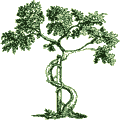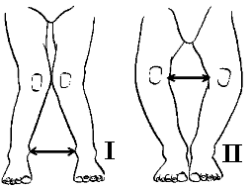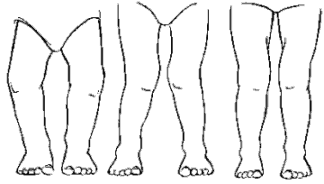
|
|||||||
Bowlegs and Knock-knees
What is it?
Bowleg (or genu varum) is a condition where the legs are bowed outwards in the standing position. The bowing usually occurs at or around the knee, so that on standing with the feet together, the knees are far apart.
Knock-knee (or genu valgum) is a condition where the legs are bowed inwards in the standing position. The bowing usually occurs at or around the knee, so that on standing with the knees together, the feet are far apart.

Fig I: Knock-knee (genu valgum) intermalleolar distance
Fig II: Bowleg (genu varum) intercondylar distance
What causes it?
Most people have some degree of bowleg or knock-knee and is considered within the limits of normal structure and function. During development in the first few years of life, because of rapid and differential growth around the knees, most children are bowlegged from birth till age 3, then become knock-kneed till age 5, then straighten up by age 6 or 7. In most children, even as they grow through these phases, the bowleg and knock-knee are not severe, and do not engender concern on the part of the parents. In some instances, the bowleg or knock-knee gets quite obvious, and becomes worrisome for the parents.

Fig: Normal evolution from bowlegs (age 2) to knock-knees (age 3) to normal valgus (age 5)
There are, of course, more serious causes of bowleg and knock-knee. They include the following:
- Blountís disease - a condition of severe bowleg that occurs usually in black children that is progressive, and may require surrgery.
- Growth disturbance - or epiphyseal dysplasia, which may be a part of a generalized bone growth disturbance.
- Post-trauma - where injury to the knee causes damage to the growth plate (also called the epiphyseal plate) and abnormal growth around the knee.
- Rickets. Lack of vitamin D intake, or inability to metabolize Vitamin D due to kidney disease can cause growth disturbance of the bones in the body, including the knee.
What does your doctor do about it?
In the majority of children with bowlegs or knock-knees, the cause is physiological, if they fall within the age range mentioned above. A good rule of thumb to follow is the measure of the intercondylar distance for bowlegs and the intermalleolar distance for knock-knees. In a young child, if the distance is less than 2 inches, there is no need for concern that something is amiss. Periodic observation and measurements are all that is needed.
More detailed work up may be needed under the following circumstances:
- If the bowleg or knock-knee appears outside the age range mentioned above, i.e., bowleg beyond age 3 and knock-knee beyond age 7.
- If it is unilateral.
- If the intercondylar or intermalleolar distance is more than 2 inches, or is rapidly progressing, i.e., more than Ĺ inch within six months.
- Associated symptoms like pain or limp, or signs of Blountís disease, rickets, or other disease syndromes.
NOTICE: The information presented is for your information only, and not a substitute for the medical advice of a qualified physician. Neither the author nor the publisher will be responsible for any harm or injury resulting from interpretations of the materials in this article.
Questions
or comments? Post your thoughts in the Orthoseek
Message Forum!
Find a pediatric orthopedic surgeon
in an area near you.
Home | About Us | Orthopaedic Topics | Message Forum
![]()
Comments, questions, or suggestions are welcome. Please
contact us using this form.